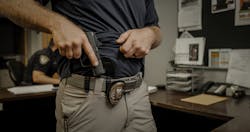When it comes to the topic of carrying a back up gun (BUG), or second handgun on duty, there are a lot of varying opinions as to the value, tactics, etc. There are those who say BUGs should be avoided and even administratively prohibited. After all, if you can’t hang on to one gun, why would the agency want you to have two? This outlook assumes you lost your primary duty sidearm in a fight or due to negligence. On the other side of the argument is the outlook that the fastest reload is a second gun, or the possibility of a catastrophic malfunction with your primary firearm, giving you the BUG as your only option to stay in the fight—and potentially have any chance of surviving much less emerging victorious.
Many BUGs also serve very well as off-duty guns because they are smaller, easier to conceal and more comfortable to carry. Given the selection of contemporary handguns that are available in 9mm (the most popular duty caliber for law enforcement as of this writing) and have a capacity of 10 or more rounds, some guns usually considered only for off-duty use are almost the equal of many duty weapons. As an example, let’s look at the Glock Model 43X or 48 as compared to the Glock Model 19. The G48 is the same height and length as the G19 but is significantly thinner. Of course, the G19 has a 15 round magazine capacity compared to the G48’s 10 round capacity. But with aftermarket magazines, the G48 can also have a 15 round capacity making it the equal of the G19. Since the G43X is simply a G43 slide assembly on top of a G48 frame, those same aftermarket magazines make the G43X a 15+1 capacity weapon as well. Both the G43X and G48 are popular off-duty weapons and would certainly serve well as BUGs.
There are plenty of other options available beyond those. The Sig P365 9mm is another 10+1 capacity 9mm handgun that is comparatively small, ergonomic, easy to conceal, comfortable to carry and, with just one spare magazine, gives you plenty of ammo count for off-duty carry. That same compact package would make an excellent BUG to your duty weapon and would be pretty easy to secure in an easy to access holster even while in uniform.
Another excellent option is the Springfield Armory Hellcat. Referred to on their website as a micro-compact, this 11+1 capacity (or 13+1 with their extended magazine option) 9mm handgun took the shooting industry by storm when it was first released. Many experienced shooters were quite surprised when this gun hit the market due to its small size but big capacity and in a full-size defense caliber. Like the other small size but full caliber handguns mentioned above, these guns are designed with accessory rails and they are available with optics-ready slides as well as sleek low-profile yet high-visibility sights.
With such options available, the question of whether or not you should be carrying a Back Up Gun really does become a matter of agency general orders and personal preference. If it’s permitted by the agency, why wouldn’t you? It’s recommended that you pick a BUG of similar functionality to your duty weapon. That way you’re not mixing and matching operating systems, potentially causing yourself confusion and hesitation in high-stress high-threat situations—which is the only kind of situation you’ll need your BUG in, right?
Positioning for carry and whether or not you’d carry a spare magazine for the BUG are the next questions. It’s hard to hide a BUG when wearing a summer uniform unless it’s in an ankle holster or under your duty shirt. Most agencies, in our experience and research, require the BUG to be concealed because let’s face it—carrying two guys out in the open just looks a little more “cowboyish” than any agency wants (or will approve of). Ankle holsters are the choice of many officers but have two downsides: They can offset your balance if you have to run (along with causing security concerns because of the additional tension/stress on holsters of running) and they can be difficult to get to when you need them. Carrying a holster mounted on your concealed vest or otherwise under your uniform shirt can ruin that professionally tailored look and also make it slow to get to the weapon when you need it.
The only remaining option is to carry the BUG in a holster that doesn’t look like a holster—something that appears to be a utility pouch or such—mounted on a gear vest/external armor carrier or on your gunbelt. And let’s admit something right here: real estate on the gunbelt is at a premium already. Adding another gun is a bit unrealistic.
Thankfully, off-duty you don’t have the same challenges. The BUG on-duty becomes the concealed carry off-duty weapon without much trouble at all. Even in the summer months when you might just be wearing a t-shirt over your shorts, as long as you don’t tuck it in, you can easily carry your off-duty weapon inside your waist band (IWB) in a variety of positions. With today’s options you can also carry a spare magazine IWB as well. The key and most important thing to remember is that it takes training and practice to access your off-duty weapon and reload drills are entirely different as well. Accessing both the firearm and the spare magazine are different from when it’s all on your gunbelt.
Consider all of this when you’re making your selections for BUGs or off-duty weapons. Find out what appeals to you and is safe and then equip yourself with the right weapon, the right holster(s), the right spare magazines and everything you need for the carry method you choose.
About the Author
Lt. Frank Borelli (ret), Editorial Director
Editorial Director
Lt. Frank Borelli is the Editorial Director for the Officer Media Group. Frank brings 20+ years of writing and editing experience in addition to 40 years of law enforcement operations, administration and training experience to the team.
Frank has had numerous books published which are available on Amazon.com, BarnesAndNoble.com, and other major retail outlets.
If you have any comments or questions, you can contact him via email at [email protected].

